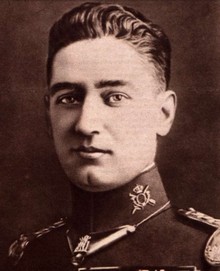Ángel García Hernández facts for kids
Quick facts for kids
Miguel Ángel García Hernández
|
|
|---|---|

García Hernández from the cover of Crónica in December 1931
|
|
| Born | 29 January 1899 Vitoria, Álava, Spain
|
| Died | 14 December 1930 (aged 31) Huesca, Spain
|
| Nationality | Spanish |
| Occupation | Soldier |
| Known for | Role in Jaca uprising |
Miguel Ángel García Hernández (born January 29, 1899 – died December 14, 1930) was a Spanish soldier. He was one of the main leaders of the Jaca uprising. This was a failed attempt to overthrow the monarchy, which is a system where a king or queen rules.
He was quickly put on trial and then executed by a firing squad. This event made many people very angry across Spain. Just a few months later, when the Second Spanish Republic was formed, he became a hero.
Early Life
Ángel García Hernández was born in Vitoria, Spain, on January 29, 1899. He came from a family of soldiers.
He joined the army and fought in a war in Morocco. During this time, he saw many problems within the army. These issues grew worse during the time when General Miguel Primo de Rivera ruled Spain as a dictator. A dictatorship is when one person has total power over a country.
García Hernández became an artillery captain. He was sent to the military base in Jaca. There, he met Captain Fermín Galán. The two men quickly became good friends and shared similar ideas. García Hernández was one of the officers who helped plan the Jaca uprising.
The Jaca Uprising
Captain Galán started the uprising in Jaca very early on December 12. A group of officers gathered their soldiers at 5:00 a.m. They arrested the military governor. They also took control of important places like the telephone office and the train station.
At 11:00 a.m., they announced that Spain was now a Republic. This happened at the Jaca city hall. A Republic is a country where people elect their leaders.
Two groups of soldiers were formed to march towards Huesca. Captain Galán led one group by road. The other group, led by Salvador Sediles, went by train. However, the train tracks were removed in one place. So, Sediles' group had to walk and join Galán's group. Together, they marched towards Huesca. They expected other soldiers there to join their rebellion.
On December 13, 1930, near Huesca, the rebels met the government's army. Galán had to decide whether to fight or try to talk. He believed many of the government soldiers would support their cause. So, he chose to talk.
Captain García Hernández and Captain Salinas drove with a white flag towards the government lines. But when they arrived, they were immediately arrested. Then, the government troops started firing at the rebels.
Galán refused to order his soldiers to fight back. He said that "brothers cannot fight each other." He told his troops to retreat. The rebel army then broke apart. Some soldiers went back to Jaca, some were arrested, and others tried to escape. Galán himself surrendered later that day.
His Death and Legacy
On December 14, Galán and García Hernández faced a very quick trial. They were sentenced to death. Other officers received life imprisonment. The trial happened in Huesca. Both captains were to be shot by a firing squad. A firing squad is a group of soldiers who shoot someone as a punishment.
The highest military leader in Aragon approved the sentence. The government in Madrid also agreed. Galán and García Hernández were shot in Huesca at 3:00 p.m. on December 14, 1930. They chose to face the firing squad without blindfolds.
The Prime Minister of Spain, General Damaso Berenguer, thought these executions would stop revolutionary ideas in the army. But he was wrong. The executions made many people very angry at the government.
A famous poet, Rafael Alberti, later wrote about how the executions affected Spain. He said that the sound of the bullets echoed across the country. He also mentioned that these events led to a huge wave of public anger.
Within four months, these strong public protests led to the end of the monarchy. Galán and García Hernández became heroes of the Second Spanish Republic. Their pictures were displayed in public buildings and homes across Spain. There is even a street named García Hernández in Jaca.
In October 2017, the graves of Fermín Galán Rodríguez and Ángel García Hernández in Huesca were recognized as important historical sites. They are now specially protected.
See also
 In Spanish: Ángel García Hernández para niños
In Spanish: Ángel García Hernández para niños

